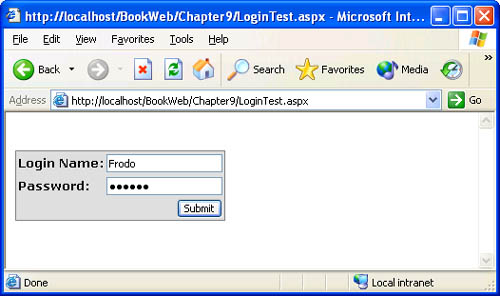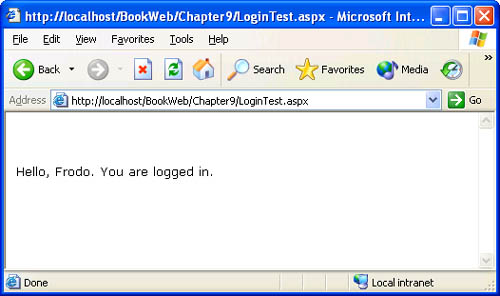Putting It Together The Login Example
Putting It Together ”The Login ExampleWe'll now develop a Login control that implements postback event handling and data processing functionality to allow a user to log into a Web site. In Chapter 8, we developed a LoginUI control that renders two HTML text boxes and a button and provides unique names for those elements. We'll now derive from that control and add event-handling and data-processing functionality to it. Note that LoginUI derives from Control to demonstrate rendering only; we are reusing LoginUI only because it has most of the functionality we need. In general, if you want to implement a control such as Login , you should derive from WebControl and use WebControl 's built-in style properties. Listing 9-11 contains the code for Login . The highlighted code is responsible for ensuring that, on postback, the page calls Login in the postback data-processing and event phases. We'll discuss the sample after the code listing. Listing 9-11 Login.cs usingSystem; usingSystem.Collections.Specialized; usingSystem.ComponentModel; usingSystem.Web.UI; namespaceMSPress.ServerControls{ [DefaultEvent("Logon")] publicclassLogin:LoginUI,IPostBackDataHandler,IPostBackEventHandler{ privatestaticreadonlyobjectEventLogon=newobject(); privatestring_password; privatestring_userName; [Browsable(false), DesignerSerializationVisibility(DesignerSerializationVisibility.Hidden)] publicstringUserName{ get{ return((_userName==null)?String.Empty:_userName); } } [Browsable(false), DesignerSerializationVisibility(DesignerSerializationVisibility.Hidden)] publicstringPassword{ get{ return((_password==null)?String.Empty:_password); } } [Category("Action"), Description("Raisedwhenthebuttonisclickedtologin")] publiceventEventHandlerLogon{ add{ Events.AddHandler(EventLogon,value); } remove{ Events.RemoveHandler(EventLogon,value); } } boolIPostBackDataHandler.LoadPostData(stringpostDataKey, NameValueCollectionvalues){ //UserInputNameisdefinedinLoginUI. _userName=values[UserNameInputName]; //PasswordInputNameisdefinedinLoginUI. _password=values[PasswordInputName]; //Checkwhetherthebuttonwasclickedonthe //client.Ifitwas,tellthepageto //invokeIPostBackEventHandler.RaisePostBackEvent. //ButtonNameisdefinedinLoginUI. stringbuttonValue=values[ButtonName]; boolbuttonClicked= (buttonValue!=null)&&(buttonValue.Length!=0); if(buttonClicked)Page.RegisterRequiresRaiseEvent(this); //Returnfalsebecausewedonotwanttoraisea //changedevent. returnfalse; } voidIPostBackDataHandler.RaisePostDataChangedEvent(){ } voidIPostBackEventHandler.RaisePostBackEvent(stringeventArgument){ OnLogon(EventArgs.Empty); } protectedvirtualvoidOnLogon(EventArgse){ EventHandlerlogonHandler= (EventHandler)Events[EventLogon]; if(logonHandler!=null){ logonHandler(this,e); } } protectedoverridevoidOnPreRender(EventArgse){ base.OnPreRender(e); Page.RegisterRequiresPostBack(this); } protectedoverridevoidRender(HtmlTextWriterwriter){ //Ensuresthatthiscontrolisnestedinaserverform. if(Page!=null){ Page.VerifyRenderingInServerForm(this); } base.Render(writer); } } } The Login control accomplishes the following:
Listing 9-12 contains a page that uses the Login control and handles its Logon event to validate the user. Figures 9-9 and 9-10 show the page viewed in a browser before and after the form is submitted. Listing 9-12 LoginTest.aspx <%@PageLanguage="C#"%> <%@RegisterTagPrefix="msp"Namespace="MSPress.ServerControls" Assembly="MSPress.ServerControls"%> <html> <head> <scriptrunat="server"> voidlogin1_Logon(objectsender,EventArgse){ if(ValidateUser()){ login1.Visible=false; label1.Text="Hello"+login1.UserName+ ",youareloggedin."; } else{ label1.Text="Loginfailed."+ "Enteryourusernameandpassword."; } } boolValidateUser(){ //Performlogictoauthenticateuser.We'll //simplyreturntrueforthisdemo. returntrue; } </script> </head> <body> <formrunat="server"> <br> <msp:Loginid="login1"runat="server"ButtonText="Submit" NameLabel="LoginName:"PasswordLabel="Password:" BackColor="Gainsboro"BorderColor="Gray"BorderStyle="Solid" BorderWidth="1px"FontFamily="Verdana"FontSize="10" FontBold="True"onLogon="login1_Logon"/> <br> <asp:Labelid="label1"runat="server"/> </form> </body> </html> Figure 9-9. LoginTest.aspx viewed in a browser on first request Figure 9-10. LoginTest.aspx viewed in a browser after data is entered and form is submitted |
EAN: 2147483647
Pages: 183

